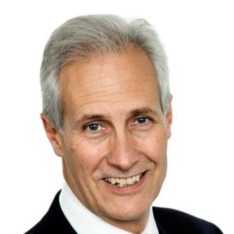The Dangers to Prosperity All Around Us

Looking back at the 20th century there were great social, political and economic challenges. Technological advances accelerated and mass communication shrank the planet. In the process we embarked on two catastrophic world wars, whilst in peacetime economic booms and busts ensured human progress was as uneven as it was cathartic.
The first two decades of the new century saw a continuation, though thankfully without too many widespread military conflicts. At a global level, diseases have been eradicated, life expectancy extended, quality of life improved.
Of course, progress has remained uneven and there have been inevitable winners and losers. Overall, however, we are moving in the right direction and, during the last half-century, the number of people who remain in extreme poverty has fallen faster than at any time in human history. According to the World Data Lab, even during the last four years the number in absolute poverty has fallen from 652mln to 588mln. The chart below shows the dramatic decline since 1970: –
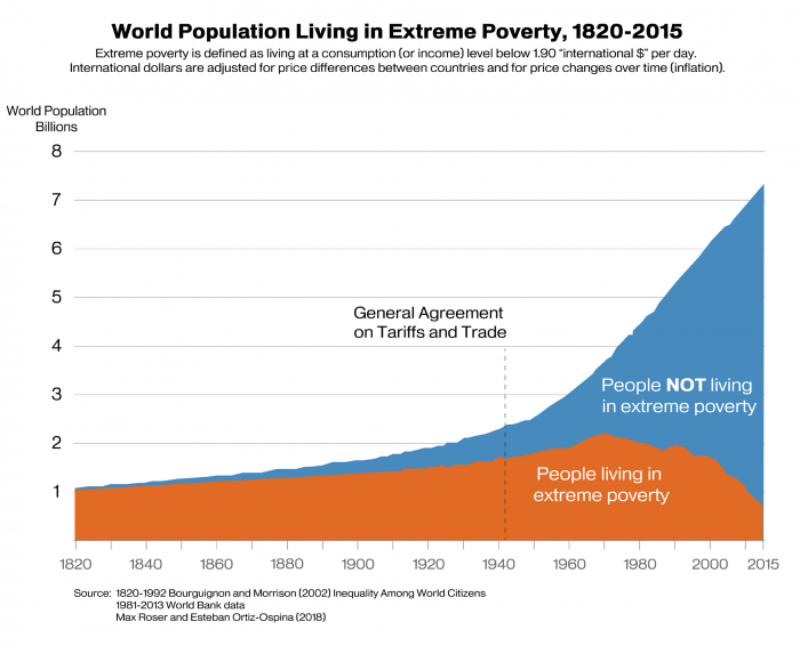
At the heart of this triumph of humanity is freedom to trade. The incredible work of the World Trade Organisation (WTO) is not to be understated. Nonetheless, the WTO is not without their critics and other institutions have fallen behind in their efforts to drive improvements in the lot of mankind. Additionally, despite this impressive evidence in favour of free trade, it remains under constant political threat. After all, free trade is not the solution to all the ills of humanity; some always benefit far more than others. There has been a backlash, but place trade in fetters and productivity suffers; when productivity declines human progress slows.
Protectionist policies benefit minorities and lower the trend rate of economic growth. Nonetheless, during the last decade populist protectionist policies have garnered support in many developed countries. Global supply chains have shortened and a global depression has been averted only by the aggressive interventions of developed nation central banks.
In the decade ahead, historically low interest rates should prompt governments to embark on long-term investment in infrastructure. They should borrow while they can, and the demographic forces which have driven inflation lower during the past two decades will lessen. The table below shows how Generation Y has started borrowing since 2015, reversing a decline in train since 2000. It will be the middle of the 2020’s before Generation X retirees begin to partially offset that impetus by their increased saving:
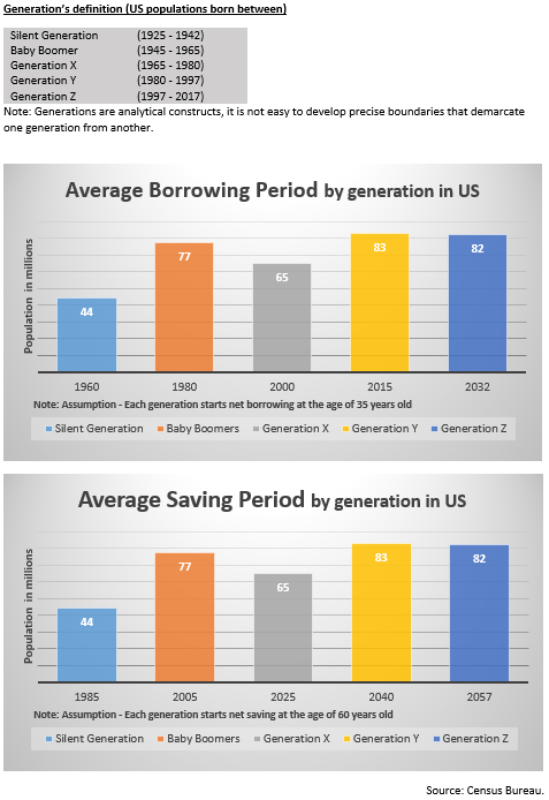
With this Gen Y increase in borrowing, in order to consume, will come a rebound in inflation and, with it, the need for higher interest rates. I do not anticipate the beginning of a bond bear market; the outstanding debt overhang will insure over-leveraged economies stall rapidly in response to tighter monetary conditions. This in turn may prompt central banks to ease monetary policy despite inflation, or for government regulation, especially in relation to bank capital requirements, to be relaxed. Over the next decade both bond and stock markets may be stuck within a broad range, although the risks are on the downside.
90 years of the US Stock Market
The benefit of viewing financial markets over multiple decades is that one can observe the long-run trends absent the short-run noise. Here is the S&P 500 since 1929:
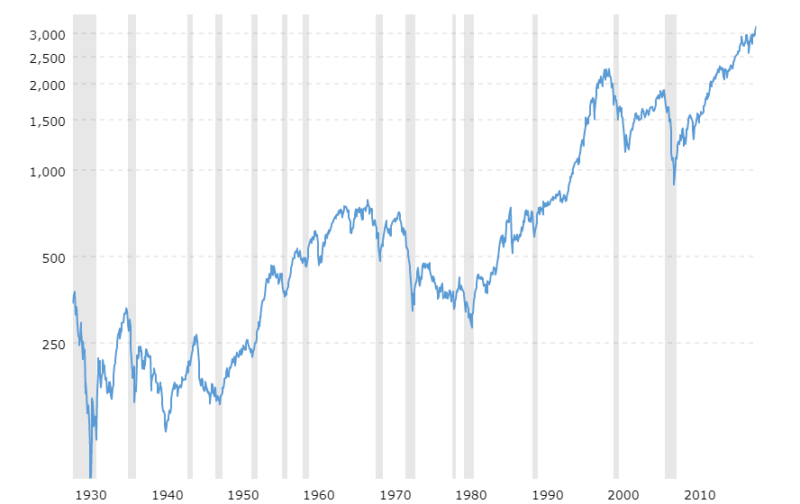
There have been just two decades since 1930 when the S&P 500 ended the period lower; the 10 years to 1940 and 2000 through 2010. It is worth mentioning, however, that the inflationary 1960’s and 1970’s were decades which saw very limited stock price appreciation: and in inflation-adjusted terms these decades delivered scant succour to equity investors. Bondholders fared even worse.
The recent stock market strength since the financial crisis may appear unjustified when compared to the anaemic economic growth of the last decade, but, as the chart below shows, the earnings per share (brown line) combined with historically low interest rates, help to justify these inflated valuations:
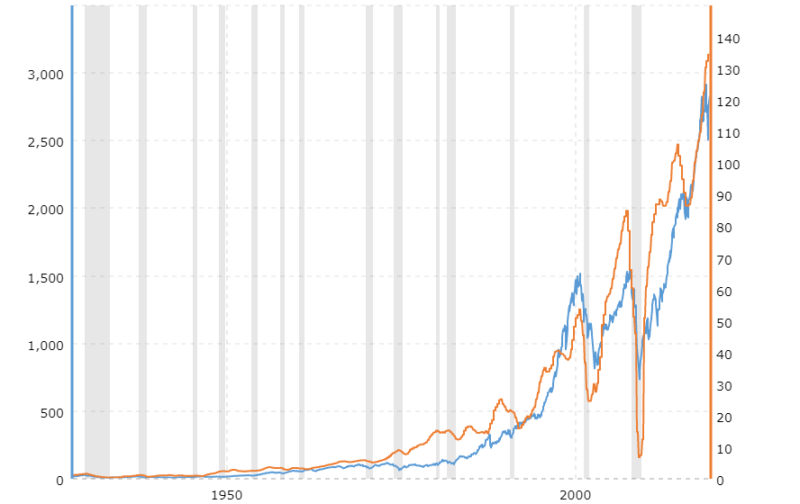
It is worth remembering the difference between company earnings and earnings per share. The latter can be inflated simply by reducing the number of shares in issue. As interest rates have collapsed, debt financing has become more cost effective than equity financing. Firms have embraced debt to finance new projects but also to redeem shares, thereby magically increasing their earnings per share. Assuming corporate leverage has its limits, during the next decade there will be less opportunity to grow earnings per share through such financial sleight of hand.
If the principal driver of stock market returns over the last decade has been the steady lowering of interest rates and an increase in corporate leverage, then the next decade will require substantially more leverage or a marked increase in economic growth in order to maintain the upward momentum in prices. There are, of course, smaller international markets where interest rates remain elevated and corporate leverage subdued, but these are exceptions to the broader rule. The US has more latitude to cut interest rates than Europe or Japan but the US stock market has led the way during the current bull market and global stock markets are historically highly correlated.
Where should investors look for returns?
The chart below compares bonds versus stocks since 2000:
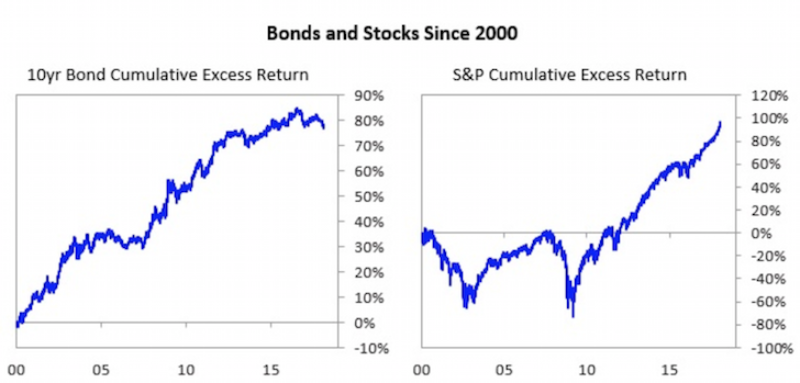
What are the alternatives? To begin here is a table showing the long-term return from a balanced stock and bond portfolio:
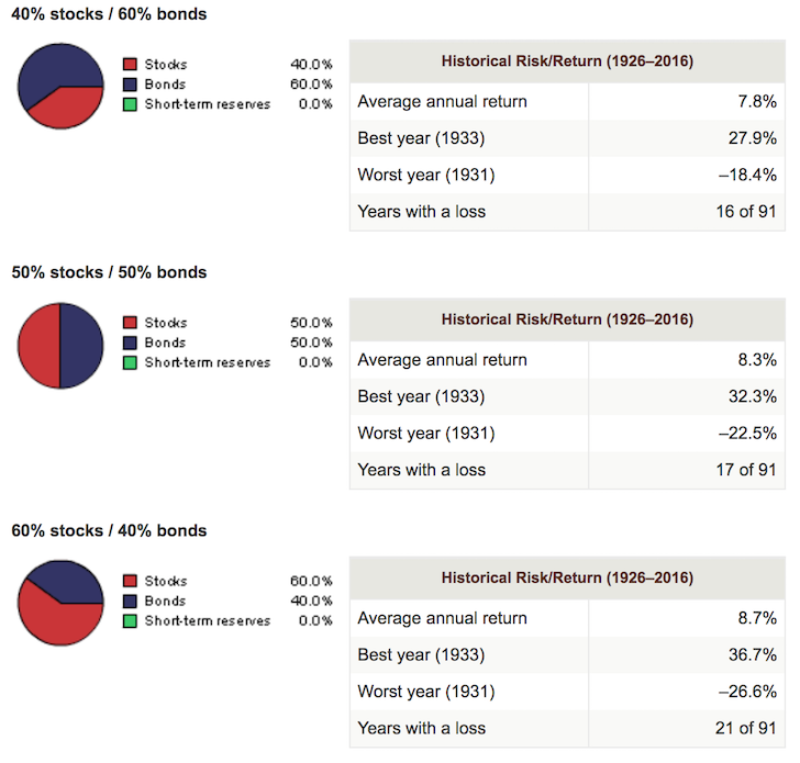
The classic mix of 60% stocks and 40% bonds has delivered 8.7% over the 91 years to 2016. Investors incurred losses in 21 of those years.
A more aggressive portfolio, with a higher stock weighting, combined with a money market investment, might be a solution:
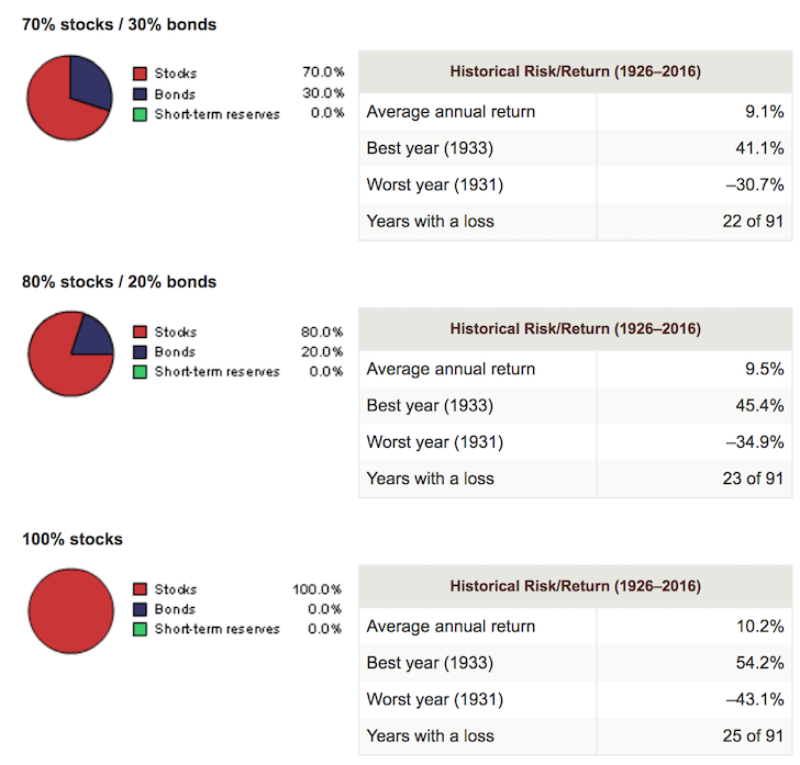
Other alternatives to a stock and bond portfolio include Real Estate and Infrastructure, but these sectors remain sensitive to interest rates and are therefore quite highly correlated to fixed income. Their enticing returns are also a function of their lack of transparency and liquidity. To succeed in such assets a much longer-term investment horizon is required. These assets are difficult to evaluate and price discovery is often challenging.
Another alternative or addition to a portfolio is Commodities. As an asset class they are far less homogenous, making investment a more nuanced affair. Gold may rise as copper falls, wheat and corn may rise together, then diverge for years. Additionally, in the long run, real, inflation adjusted, commodity prices almost always fall: in asset management parlance, they have a negative expected real-return. This is a function of human endeavour. We raise more from an acre of land through technological progress, we drill and frack more efficiently, our geological survey techniques improve. The triumphs of human ingenuity are endless.
Finally, commodities offer no yield, no dividend, no coupon. These are trading assets; by all means follow their trends but do not forget, trends always end.
Looking ahead to 2030, active, tactical asset allocation may appear beguiling, but trading asset markets is a zero-sum game. For every winner there must be a loser. I would, nonetheless, commend two consistent strategies which have proved their worth over the long-run, Value and Trend Following. Tread carefully, however, as Lord Keynes famously observed, ‘Markets can remain irrational longer than I can remain solvent.’ Value has underperformed for the last decade, even though it has delivered excellent results over a longer time horizon. Periods of trend-less-ness can last for years and price patterns seldom repeat though they may well rhyme.
Aside from financial markets, there are many other economic factors to consider between now and 2030. After successive tax cuts, the room for the US government to go further without also curbing spending is limited, yet politicians, left and right, continue to promise more. A rude awakening cannot be ruled out during the next decade and this may sow the seeds for another great recession. However, lightning seldom strikes twice in the same manner and I fear that reckoning will be postponed by more pork barrel spending funded by long-term borrowing at the lowest interest rates in history. Financial leverage is a game of the greater fool, but when a government issues debt in its own medium of exchange, especially if that medium remains the world reserve currency of choice, it has little to fear in the short run. Every dollar of government debt is deferred taxation for the purposes of immediate consumption. For the political classes, paying back the loan will be someone else’s problem.
Financial leverage, even when wielded by the minter of money, possesses a dark side. As an individual, corporation or government becomes more leveraged so they become more sensitive to even a small change in interest rates. Whilst independent central banks continue to provide support by the manipulation of interest rates, all is well, but at some point the markets may lose faith in their omnipotence.
Whilst my Austrian economic inclinations favour sound money and an unwinding of decades of excess, the fabric of society could be rent asunder by the collapse of the current financial system. I believe central bankers are cognisant of the risk, but to force a normalisation of interest rates is not their mandate. Even the recent quantitative tightening pursued by the Federal Reserve was short-lived and limited by comparison with the monetary easing and balance sheet expansion that preceded it.
For the next decade I envisage more extreme experiments with monetary policy, combined with a return to fiscal largesse, all of it aimed at maintaining the status quo. Eventually the experiments will fail but by that point new leaders will be in office. I do not envy their task.

